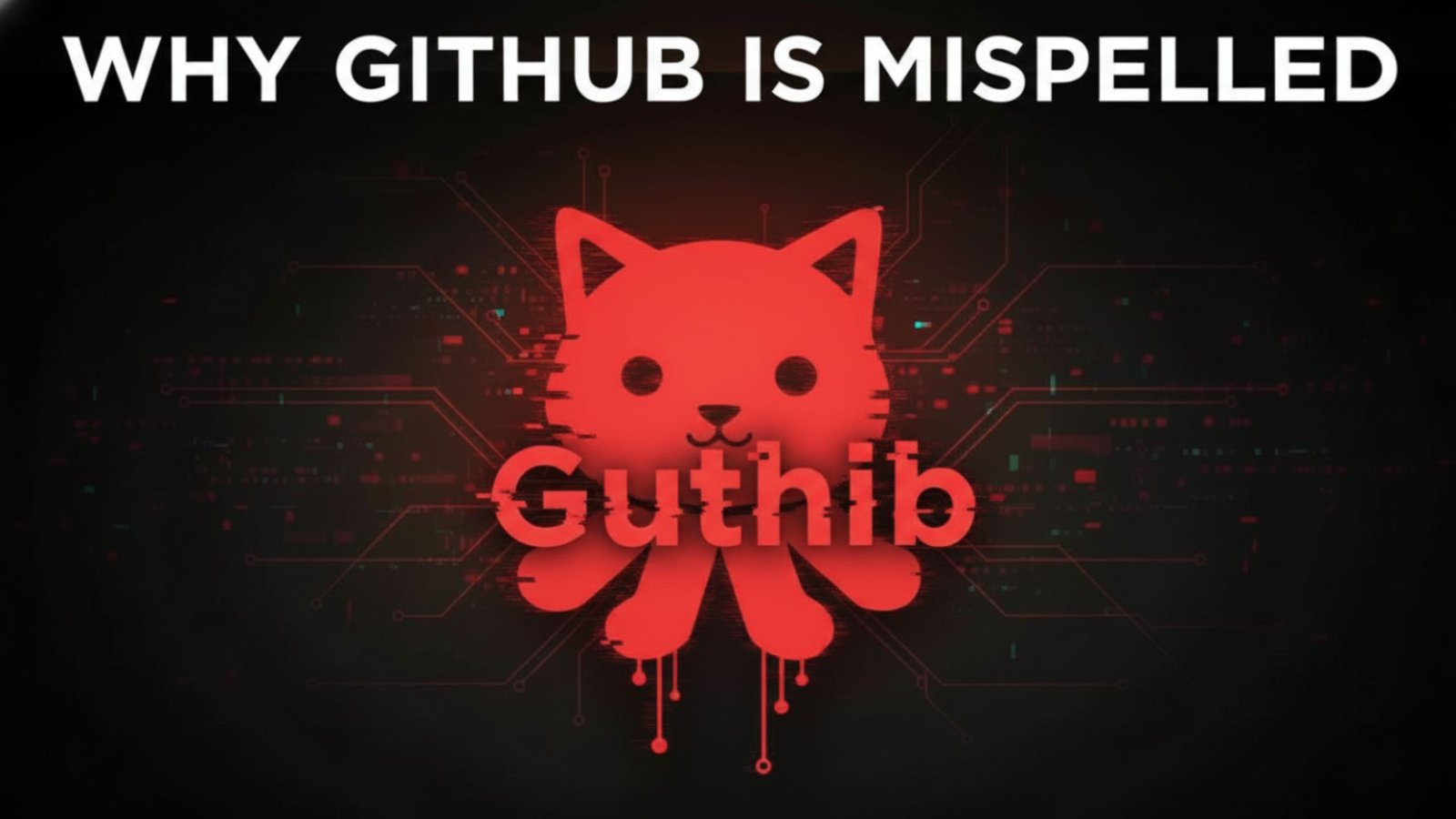Half a Million People Spell GitHub as “Guthib”– Every month, more than 500,000 users worldwide accidentally type “Guthib” instead of “GitHub”, landing on a cleverly designed website that politely corrects them. This widespread typo reveals fascinating insights about digital behavior, branding recognition, and user psychology on the internet. Let’s explore how this phenomenon occurs, what it means for brands, and what lessons we can learn from the Guthib typo story.
Understanding the “Guthib” Typo Phenomenon
GitHub, the world’s leading platform for developers to collaborate on code, enjoys global recognition. However, the common misspelling “Guthib” has become a viral curiosity. The domain guthib.com receives hundreds of thousands of visits each month, mostly from users who mistype GitHub in their browser.
What’s more interesting? The site humorously acknowledges the error with a message like “You spelled it wrong — it’s GitHub, not Guthib.” This witty response not only corrects the user but also reinforces the real brand name.
Why So Many People Misspell GitHub as Guthib
The repeated typo isn’t random. Several linguistic and cognitive factors explain why “Guthib” has gained such massive accidental traffic.
1. Phonetic Similarity
The human brain tends to type what it hears or says. “Guthib” sounds somewhat similar to “GitHub” when spoken quickly. The soft “t” and “h” sounds can blend, leading to phonetic confusion.
2. Keyboard Positioning
On a standard QWERTY keyboard, the letters “u” and “i” are adjacent. A slight shift of the finger when typing “GitHub” results in “Guthib.” This makes it one of the most common proximity typing errors.
3. Auto-Correct and Browser Prediction
Some mobile devices or browsers might auto-correct “Github” to “Guthib” if the latter was mistakenly typed before. Machine learning in predictive typing can reinforce incorrect spelling patterns if repeated over time.
The Smart Strategy Behind Guthib.com
Instead of letting the typo domain go to waste, someone cleverly purchased guthib.com and created a redirect-style website that informs visitors of their error. This approach accomplishes several goals:
- Protects GitHub’s brand reputation by ensuring users don’t land on malicious typo domains.
- Educates users with humor instead of frustration.
- Captures curiosity-driven traffic, creating virality and discussion across tech communities.
This example demonstrates a form of “defensive domain strategy”—a practice where brands secure misspelled versions of their main domain to prevent misuse or phishing.
How Typo Domains Drive Massive Traffic
Typing mistakes are a natural part of human behavior, and clever marketers have long understood their potential. The Guthib case showcases how a simple misspelling can attract half a million monthly visits.
1. Direct Type-in Traffic
When users manually enter URLs into browsers, typo errors happen frequently. Sites like guthib.com benefit from direct type-in traffic, one of the most valuable traffic sources since it indicates strong user intent.
2. SEO and Curiosity Value
While typo domains don’t usually rank high on search engines, they gain traction through word-of-mouth, social sharing, and viral content. Guthib’s humorous message sparked online discussions and memes, which in turn boosted organic traffic indirectly.
3. Brand Safety and Awareness
By controlling a popular misspelled domain, brands can protect their online reputation. Without this measure, hackers or scammers could exploit these domains for phishing attacks or fake login pages, tricking unsuspecting users.
GitHub’s Branding Power and Recognition
The GitHub brand is so strong that even its misspelling gains attention. GitHub, owned by Microsoft, serves over 100 million developers and hosts countless open-source projects. Its reputation as a trustworthy coding platform has made it one of the internet’s most recognized developer brands.
Yet, this incident highlights a subtle truth: even globally dominant brands must remain vigilant about digital branding hygiene. Misspelled domains can become part of the brand’s digital footprint, whether intended or not.
Lessons for Businesses and Marketers
The Guthib phenomenon offers several valuable takeaways for companies, marketers, and entrepreneurs aiming to strengthen their online presence.
1. Secure Typo Domains
Register common misspellings and variations of your main domain. For instance:
- github.com → githib.com, guthib.com, gitgub.com
- amazon.com → amazn.com, amazoon.com, amazom.com
This prevents cyber-squatting and protects your traffic from diversion.
2. Embrace User Mistakes
Instead of punishing users for typos, use humor or gentle reminders. The Guthib site turns a potential error into a positive user experience, improving brand sentiment.
3. Monitor Your Brand Mentions
Use tools like Google Alerts, Ahrefs, or Semrush to track keyword mentions and misspellings of your brand online. Understanding how users refer to your business helps you optimize for real-world behavior.
4. Optimize for Voice and Mobile Searches
With voice assistants and touchscreen typing, brand names must be easy to pronounce and spell. Companies should consider phonetic variations during brand naming and SEO strategy.
The Psychology Behind Common Internet Typos
Human cognition isn’t perfect—especially when typing fast. Studies show that 70% of typos occur due to muscle memory errors, not lack of knowledge. When people type familiar words, their fingers rely on pattern recognition rather than conscious thought.
In the case of Guthib, the brain processes “GitHub” as a familiar term, but the fingers slightly misfire on the keyboard. This tiny slip creates a globally noticeable pattern, especially among millions of tech-savvy users typing it daily.
Typo Domains: Ethical and Legal Perspectives
While registering typo domains can be a clever defensive move, it’s a gray area when done for profit or deception. Many corporations actively file UDRP complaints (Uniform Domain-Name Dispute-Resolution Policy) to reclaim typo domains.
However, in the Guthib case, the domain redirects users to a harmless correction message, making it an example of ethical typo squatting — educational rather than exploitative.
Could “Guthib” Become a Meme Brand?
Interestingly, the typo itself has taken on a life of its own. Social media users have turned “Guthib” into a meme, referencing it in coding jokes and developer communities. This demonstrates how mistakes can evolve into internet culture, sometimes even boosting awareness of the original brand.
If GitHub decided to embrace the joke officially—perhaps with a fun Easter egg—it could further strengthen its approachable image in the developer community.
Final Thoughts: A Simple Typo That Tells a Bigger Story
The “Guthib” typo isn’t just a spelling error. It’s a mirror of how humans interact with technology, brands, and digital habits. It reveals the power of humor, brand protection, and smart online strategy.
From a marketing standpoint, the Guthib story teaches us one clear lesson: every digital interaction matters—even accidental ones. When brands anticipate mistakes and respond with creativity, they not only protect their reputation but also earn respect and virality.
AITeam is the dedicated editorial team of Android Infotech, consisting of experts and enthusiasts specialized in Android-related topics, including app development, software updates, and the latest tech trends. With a passion for technology and years of experience, our team aims to provide accurate, insightful, and up-to-date information to help developers, tech enthusiasts, and readers stay ahead in the Android ecosystem.
For more about our team, visit our About Us page.




Leave a Reply